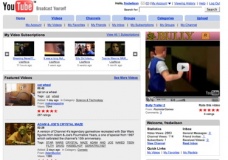YouTube
| Community | Anyone on the web |
| Membership | Anyone with creation of account |
| Privacy | features that support privacy |
| Self Identity | Profile, Videos, Friends, "Likes" |
| Features | Sharing Photos, Comments |
| Status | |
| Launch Date | February 14, 2005 |
| Users | Hundreds of Millions |
Contents
History
YouTube was founded by Chad Hurley, Steve Chen, and Jawed Karim in 2005 after they had difficulty sharing videos with each other. All three of the founders were previously employees of PayPal, an online company that acts as its users' digital wallet. YouTube's first headquarters were located above a pizzeria in San Mateo, California. It started as an angel-funded enterprise from a makeshift office, however, in November 2005, Sequoia Capital invested an initial $3.5 million[4]. When YouTube first began, the website had practically no interface. It did not indicate that it was focused towards video content anywhere on the site. The first video clip to be uploaded on to the website was by Karim himself, titled "Me at the zoo". [5]
After being funded by Sequoia Capital, a beta came out and was quickly followed by a real version. During the summer of 2006, YouTube gained popularity and was one of the fastest growing sites on the Web, uploading more than 65,000 new videos and obtaining 100 million video views per day in July[6]. The site grew rapidly and was bought by Google in October, 2006 for $1.65 billion[7]. YouTube has gone on to make deals with movie producers as well as television stations in order to display their content on YouTube. Google+ has adopted YouTube as its video viewing mechanism.
iPhone App
In 2007, Apple released iOS 6 which for the first time did not come with a YouTube application natively installed. At the time, 25% of all YouTube views were on mobile devices. Apple had announced before the iOS release that YouTube would no longer be pre-installed, and within a month YouTube created an app of its own. Controversy began begin the technology giants, Apple and Google, because Google was given limited control of the native YouTube app because of its integration within the operating system. The most notable limitation was control of ads. Apple refused to allow YouTube to display ads before a video. YouTube is not the only disagreement between Google and Apple in recent months. Apple announced in July 2012 that it would no longer use Google Maps to power the iPhone Maps application.[8]
Funding
Similar to Facebook, YouTube is a free website that brings in revenue through advertising. Advertisers spend thousands of dollars so that their products will be featured on the top watched videos. YouTube enforces strict community and technical guidelines for all of its advertisements[9]. The site aims to be fair and consistent with its policies in order to benefit its users, advertisers, and partners. It reserves the right to reject or approve any ad from the site that is deemed inappropriate or intrusive. Refunds are not issued for promotions where the related ads or videos are disabled, suspended, or age-restricted due to policy violations[9], so the site profits even from unsuccessful advertisements. With thousands of advertisements on YouTube, more than enough money is provided to fund the site.
Copyright Concerns
YouTube faces tremendous copyright issues mainly because it does not monitor the content of any videos.YouTube does not allow users to upload pornography or other videos that are detrimental in nature. Also copyrighted materials are not allowed to be uploaded. This, however, has not been a deterrent to thousands of people. There are millions of videos on YouTube that are illegal, in terms of copyrighted material, but YouTube does not take them down on their own. In fact YouTube makes little to no effort to enforce the policies that it lists unless a user or company has brought an issue to their attention. This creates a problem for many musical artists who rely on music purchases for their well being. Because YouTube does not actively seek out and remove illegal material this job is left in the hands of those concerned.
On the other hand, some artists may see the upload of their music as a benefit. YouTube has created a different approach in getting one's name out without needing the resources, and the funding to afford a studio to record. One example is an artist named Karmin[10] - she makes covers to mainstream songs and for one of her covers has over 77 million views. YouTube changes the norm of becoming "famous" and allows artists to release music and showcase their works for the love of making music. Another less known example is a movement that's called REMIXED[11], which was about bringing two YouTube artists together to collaborate and make a production. One artist produces Dubstep music with only his voice and was paired with a hip hop dancer, who together came together and made a storyline about being inside a video game. YouTube is a place to make opportunities like this possible, and really allows for a new type of innovation.
Movies also have to deal with copyright concerns because they can be uploaded in pieces and go relatively unseen by the movie producers. Over the past five years, there has been an ongoing lawsuit between YouTube and Viacom. Viacom claimed that YouTube failed to remove unauthorized shows like "The Daily Show With Jon Stewart" and other copyrighted shows from the site. The court went back and forth, trying to decided if this was indeed a copyright infringement. On April 4, 2012 it was decided that it was a violation of copyright, but the two companies decided to arrange a deal in which YouTube will allow users to ren Viacom's Paramount Pictures movies[12].
Third-Party Claims
Youtube has incorporated a set of content-identifying tools which third-party companies who have with a commercial partnership with Youtube may use in order to search the website for videos matching their content. This is how in many cases unauthorized uploads of music videos or clips from television or movies by individual youtube users are found and removed.
Ethical Issues
Anonymity
It is difficult to stop a behavior effectively on youtube. Unless users give out personal information directly or through footage that can be corroborated with other online content, it can be impossible to identify users. Additionally, viewers can also use third-party ripping programs to download a video to their hard disk. For example, there is a YouTube to Mp3 Converter website [13], where users are able to download videos to their computer. If a user did not want to pay for a downloaded song from the iTunes Store, they could try to convert a YouTube video of the song into a mp3 file and then access the song on their computer. Also, users who post content or perform actions the administration disagrees with are usually punished by the removal of the offending content or banning the poster. These are ineffective deterrents because a user banned for harmful or illegal actions can resume almost immediately by creating a new account to circumvent the ban. Similarly, removed content can be reposted from a downloaded copy by making a small change to the content and posting it through a non-banned account. This set of qualities can be used for both harmful and beneficial purposes.
Anonymity in Comments
The YouTube comments section, located underneath the video, has no censorship. This means that there is always the potential for derogatory or offensive content to be posted online. As mentioned above, since YouTube is an mostly anonymous environment, it is difficult for YouTube moderators to track and censor the users who are posting this harmful and sometimes offensive material.
Benefit
Anonymity can allow YouTube users to contribute to the site more freely without worrying about the release of their personal information or relation to videos and comments. Users often wish to be personally disconnected from YouTube content for reasons other than posting inappropriate material. Anonymity can facilitate open discussion and the free flowing of content without barriers from identity.
Harm
Anonymity allows users to post content that might be offensive or inappropriate to other users without much consequence. YouTube administrators can effectively ban an account, but not necessarily a user. As mentioned, there are no mechanisms in place preventing users from creating multiple accounts. In rare cases, if a user's content is strongly incriminating of a crime, steps can be taken to identify the user in the real world and seek legal action. A recent example is the case of Dusty the Cat, in which a Facebook user posted videos of himself abusing an animal anonymously. See 4chan.
ContentID: Piracy and its Prevention
These qualities amplify YouTube's capacity to destroy privacy. As an example,
Issues of copyright infringement are prevalent in Youtube videos. More specifically, copyrighted music is commonly used without the permission of the holder. To combat this, Youtube takes step to insuring users avoid uploading videos with copyrighted content. This includes supplying copyright infringement notifications for third party users, and information for users who may have uploaded copyrighted material.[14]
Benefits
Harm
However, the ContentID system can also cause harm to users who post non-infringing content. Both bird song and motorcycle engines are known to be identified by the system as copyrighted content on some occasions, leading to ads being placed on the videos and monetization being disabled for the original creator[15]. NASA's public domain broadcasts have also been frequently removed following takedown requests from news services that rebroadcast their material [16]. This system appears to be vulnerable to exploitation by entities who wish to harass or exploit others [17].
This is problematic because some users derive
See Also
External Links
References
- ↑ Alexa Top Sites | http://www.alexa.com/topsites
- ↑ Youtube | http://en.wikipedia.org/wiki/Youtube
- ↑ Google says one hour of video is now being uploaded to Youtube every second | http://articles.washingtonpost.com/2012-01-30/national/35439542_1_youtube-channels-google-figures-show
- ↑ Woolley, Scott · (2006-03-13) · Raw and Random · Forbes.com · Forbes · 2006-07-28
- ↑ Youtube History
- ↑ lastname, firstname · (July 16, 2006) · YouTube serves up 100 million videos a day online · USA Today · November 29, 2008
- ↑ YouTube CrunchBase
- ↑ YouTube releases new iPhone app
- ↑ 9.0 9.1 YouTube Advertising Policies
- ↑ http://www.youtube.com/user/karmincovers
- ↑ http://www.youtube.com/watch?v=w2rQMyDd-N8&feature=youtu.be
- ↑ http://topics.nytimes.com/top/news/business/companies/youtube/index.html
- ↑ http://www.youtube-mp3.org/
- ↑ http://www.youtube.com/t/copyright_center
- ↑ http://thenextweb.com/google/2012/02/27/a-copyright-claim-on-chirping-birds-highlights-the-flaws-of-youtubes-automated-system/
- ↑ http://www.techdirt.com/articles/20120806/11053019945/curiositys-mars-landing-video-disappears-youtube-due-to-bogus-copyright-claim.shtml
- ↑ http://njnnetwork.com/2009/10/youtube-suspends-thousands-of-accounts/


